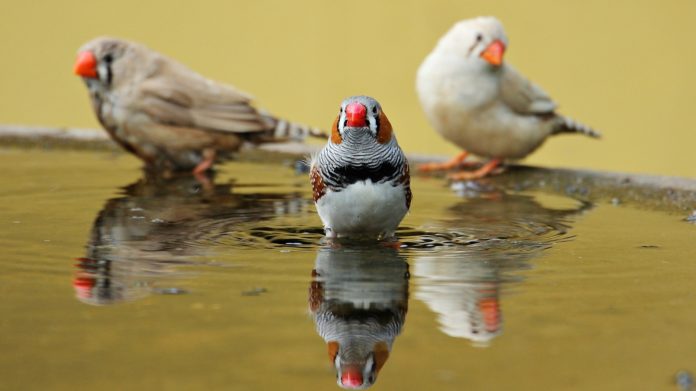You might not think you have much in common with the tweeting of birds, but new research from McGill University shows that birdsongs and human language might share the same biological underpinnings.
Dr. Jon Sakata, and his graduate student Logan James, were looking to test a popular hypothesis about human language. The hypothesis, largely credited to linguist Noam Chomsky, is that humans have an innate predisposition for language, evidenced by specific properties, such as syntactic structure or sonic patterns, that are universal to all human languages. To test this, the duo naturally turned to the zebra finch, a small, colourful songbird.
Zebra finches learn their songs in the same way, and during equivalent developmental periods, as humans learn language, making them a good model for studying language development. Young zebra finches learn their songs by listening to, and imitating the songs of, older birds. Furthermore, the songs and vocalizations of zebra finches, like human languages, seem to have some universal qualities in terms of structure and sound.
Most importantly, many of the acoustic properties that are universal across human languages also hold true in the songs of wild zebra finch populations. Are these universal properties learned through imitation and cultural propagation, or are these reflective of an underlying innate mechanism or predisposition for language and song learning?
Sakata and James sought to answer this question by training or tutoring juvenile zebra finches with 120 different randomly generated zebra finch songs. Each song was composed of the same five zebra finch syllables, four of which make up the primary elements of zebra finch phrases and all are commonly observed in natural populations. Each song, however, was unique in how these syllables were arranged, with the 120 songs representing every possible permutation of the five syllables.
The juvenile zebra finches were trained independently and exposed to each of the 120 songs in random order but in equal frequency. If songbirds have no biological predisposition for any specific song structures, then they would be just as likely to learn any of the songs.
Interestingly, Sakata and James found just the opposite – despite hearing a random assortment of sounds, the birds produced songs with similar syllable sequences and positioning. In fact, four of the birds favoured one particular song, strongly supporting the existence of some form of biological programming underlying how the zebra finches perceive and learn their songs.
The resulting songs also had a lot in common with the songs of wild zebra finches – for example, both wild and experimental bird songs tended to end with a distance call, despite this sound being only one of the five syllables used in the experiment. The results were published on Dec. 4 in Current Biology.
Intriguingly, many of the patterns of structure and sound in the bird songs resembled those found in human language and music. Shorter, higher pitched syllables often occurred in the middle of the song, while longer, lower pitched syllables often appeared at the end. This pattern of pitch is found in the phrases of human speech and in music, too.
In his book The Language Instinct, linguist Steven Pinker argues that learning language is to a human what weaving a web is to a spider or a building a dam is to a beaver: a natural instinct. The findings of Sakata and James provide preliminary empirical support for this conclusion.








































